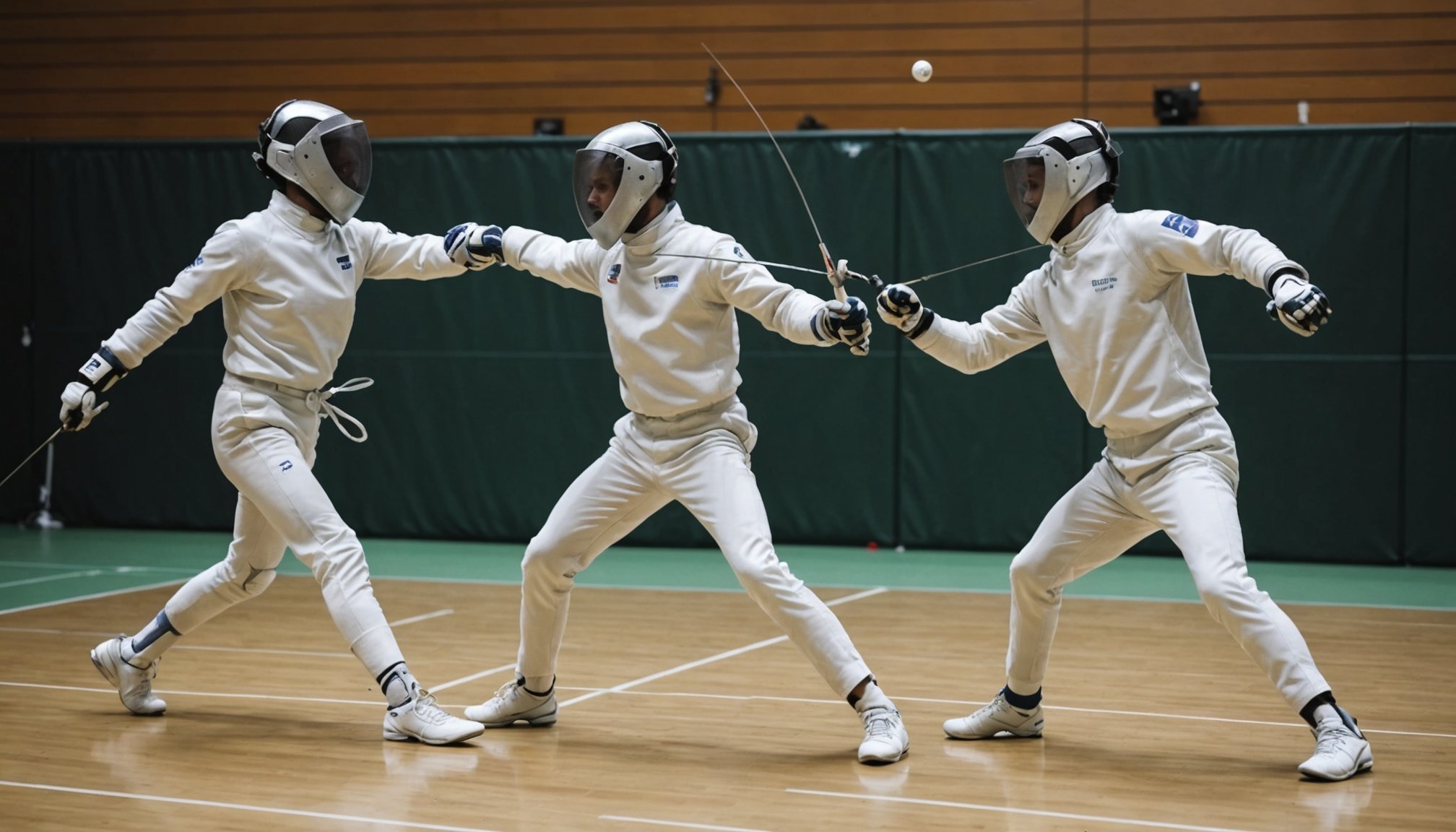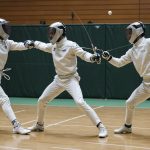Unlocking the Art of Competitive Fencing: Key Techniques to Enhance Speed and Accuracy
Fencing, a sport that combines elements of combat, strategy, and physical prowess, has been a staple of martial arts and competitive sports for centuries. To excel in this intricate and demanding sport, fencers must master a range of techniques that enhance their speed, accuracy, and overall performance. Here, we delve into the key aspects of competitive fencing, exploring the techniques, training methods, and mental preparation that can help fencers unlock their full potential.
Understanding the Weapons and Rules of Fencing
Before diving into the techniques, it’s essential to understand the three main weapons used in fencing: the foil, épée, and sabre. Each weapon has its unique rules and target areas, which significantly influence the strategies and techniques employed.
Have you seen this : Cricket bowlers” guide: top strategies to prevent shoulder injuries during long matches
Foil Fencing
In foil fencing, hits must be made with the point of the weapon and are valid only when they land on the lamé (a conductive vest) or the conductive part of the fencing mask. The foil has a pressure-sensitive button at its tip that must be depressed with a force of 500 grams or more to register a hit. The rules of right-of-way are crucial here, as they determine who has priority in scoring touches when both fencers hit on-target within a 300-millisecond window[1].
Épée Fencing
Épée fencing targets the entire body, and hits are made with the point of the weapon. The épée’s tip must be depressed with a force exceeding 750 grams to register a hit. Unlike foil, there is no off-target hit in épée; hits to the piste (fencing area) do not register. If both fencers score hits within 40 milliseconds, both are awarded touches, with no right-of-way rules applying[1].
Topic to read : Ignite your jump: dynamic plyometric training secrets for high jump excellence
Sabre Fencing
Sabre fencing allows hits to be made with any part of the blade, and there is no minimum pressure requirement. The target area includes everything above the waist, and the rules of right-of-way are used to determine who receives the touch if both fencers hit within 170 milliseconds[1].
Mastering Footwork and Movement
Footwork is the foundation of fencing, enabling fencers to move swiftly and precisely around the piste. Here are some key footwork techniques:
Advance and Retreat
- Advance: A forward movement where the front foot steps forward while the back foot follows, maintaining balance and readiness.
- Retreat: A backward movement where the back foot steps back while the front foot follows, creating distance and defensive positioning.
Lunge
- The lunge is a critical attack movement where the front foot extends forward, and the back leg straightens, propelling the fencer forward. It requires perfect balance and timing to execute effectively.
Feint
- A feint is a fake attack intended to deceive the opponent. It involves a quick, partial lunge or movement that mimics an attack but does not commit fully.
Ballestra
- A ballestra is a combination of a jump and a lunge, allowing the fencer to cover a significant distance quickly and catch the opponent off guard.
### Footwork Techniques
- **Advance:** Forward movement maintaining balance.
- Front foot steps forward, back foot follows.
- **Retreat:** Backward movement creating distance.
- Back foot steps back, front foot follows.
- **Lunge:** Forward attack movement.
- Front foot extends, back leg straightens.
- **Feint:** Fake attack to deceive the opponent.
- Partial lunge or movement without full commitment.
- **Ballestra:** Jump and lunge combination.
- Covers significant distance quickly.
Developing Offense and Defense Techniques
Offense
Offensive techniques in fencing are designed to score touches while outmaneuvering the opponent. Here are some key offensive strategies:
- Direct Attack: A straightforward attack aimed at the opponent’s target area.
- Compound Attack: A series of rapid, successive attacks intended to overwhelm the opponent.
- False Attack: An attack that is intentionally incomplete or slow to provoke a reaction from the opponent.
Defense
Defensive techniques are crucial for protecting against opponent attacks and creating counterattack opportunities.
- Parry: A defensive movement where the fencer uses their blade to deflect the opponent’s attack.
- Riposte: A quick counterattack following a successful parry.
- Disengage: A movement where the fencer withdraws their blade from the opponent’s to create distance and safety.
### Offense and Defense Techniques
#### Offense
- **Direct Attack:** Straightforward attack to the target area.
- **Compound Attack:** Series of rapid successive attacks.
- **False Attack:** Intentionally incomplete or slow attack to provoke a reaction.
#### Defense
- **Parry:** Deflecting the opponent's attack with the blade.
- **Riposte:** Quick counterattack after a successful parry.
- **Disengage:** Withdrawing the blade to create distance and safety.
The Importance of Physical Fitness and Strength
Fencing is a highly physical sport that demands strength, agility, and endurance. Here’s how fencers can improve their physical fitness:
Cardiovascular Endurance
- Engage in activities like running, cycling, or swimming to enhance cardiovascular health.
- Incorporate high-intensity interval training (HIIT) to mimic the intense bursts of energy required in fencing.
Strength Training
- Focus on exercises that build core strength, such as planks and Russian twists.
- Incorporate leg and arm exercises like squats, lunges, and push-ups to enhance overall strength and agility.
Flexibility and Mobility
- Regular stretching and mobility exercises can improve range of motion and reduce the risk of injury.
- Incorporate yoga or Pilates to enhance flexibility and balance.
### Physical Fitness and Strength Training
#### Cardiovascular Endurance
- Running, cycling, or swimming.
- High-intensity interval training (HIIT).
#### Strength Training
- Core exercises: planks, Russian twists.
- Leg and arm exercises: squats, lunges, push-ups.
#### Flexibility and Mobility
- Regular stretching.
- Yoga or Pilates.
Mental Preparation and Focus
Mental preparation is as crucial as physical training in fencing. Here are some strategies to enhance mental fortitude:
Visualization
- Visualize yourself performing well in competitions and overcoming challenges.
- Imagine different scenarios and how you would react to them.
Positive Self-Talk
- Use affirmations to boost confidence and focus.
- Replace negative thoughts with positive, empowering ones.
Breathing Techniques
- Practice deep breathing exercises to calm nerves and focus the mind.
- Use mindfulness techniques to stay present and focused during competitions.
### Mental Preparation Strategies
- **Visualization:** Imagine performing well and overcoming challenges.
- **Positive Self-Talk:** Use affirmations to boost confidence.
- **Breathing Techniques:** Deep breathing exercises for calmness and focus.
- **Mindfulness:** Stay present and focused during competitions.
Training and Practice
Consistent practice is key to improving skills in fencing. Here are some tips for effective training:
Set Specific Goals
- Define clear, achievable goals for each training session.
- Break down larger goals into smaller, manageable tasks.
Practice with Understanding
- Understand the techniques you are practicing rather than just going through the motions.
- Focus on mastering one technique at a time before moving on to the next.
Seek Feedback
- Work with a coach or experienced fencer to get feedback on your technique.
- Use video recordings to analyze your performance and identify areas for improvement.
### Effective Training Tips
- **Set Specific Goals:** Clear, achievable goals for each session.
- **Practice with Understanding:** Master techniques rather than just practicing.
- **Seek Feedback:** Work with a coach or use video recordings.
Personal Growth and Development
Fencing is not just a physical sport but also a journey of personal growth. Here’s how it can help:
Building Self-Confidence
- Success in fencing can boost self-confidence and self-assurance.
- Learning to trust yourself to make decisions and react to opponents enhances overall confidence.
Developing Critical Thinking
- Fencing requires quick reactions and strategic thinking.
- It helps develop critical thinking skills that are beneficial in many areas of life.
Enhancing Physical and Mental Fortitude
- The physical demands of fencing improve strength, agility, and endurance.
- The mental challenges enhance focus, discipline, and resilience.
### Personal Growth Benefits
- **Building Self-Confidence:** Success boosts self-confidence and self-assurance.
- **Developing Critical Thinking:** Quick reactions and strategic thinking.
- **Enhancing Physical and Mental Fortitude:** Improved strength, agility, and mental resilience.
Real-Life Examples and Anecdotes
To illustrate the effectiveness of these techniques, let’s look at some real-life examples:
The Story of Cheung Ka Long
Cheung Ka Long, an Olympic champion in foil fencing, is a prime example of how consistent practice, mental preparation, and physical fitness can lead to success. His journey from a young fencer to an Olympic champion involved rigorous training, strategic planning, and a strong mental game[3].
The Importance of Footwork
A well-known anecdote among fencers is the story of a fencer who, despite having excellent blade work, struggled with footwork. After focusing intensely on improving their footwork, they saw a significant improvement in their overall performance, highlighting the critical role footwork plays in fencing.
Fencing is a complex and rewarding sport that requires a blend of physical strength, mental fortitude, and strategic technique. By mastering footwork, developing offense and defense techniques, maintaining physical fitness, and focusing on mental preparation, fencers can unlock their full potential and achieve success in this demanding yet rewarding martial art.
### Comparative Table of Fencing Weapons
| Weapon | Target Area | Scoring Method | Right-of-Way Rules |
|
|------------------------------|
|-------------------|
| Foil | Lamé (vest and mask) | Pressure-sensitive tip | Yes |
| Épée | Entire body | Pressure-sensitive tip | No |
| Sabre | Above the waist | Any part of the blade | Yes |
In the words of Camille Prévost, a French fencing master who helped establish the basic conventions of modern fencing, “The art of fencing is not just about the physical act of fighting; it is about strategy, discipline, and the constant pursuit of improvement.” By embracing these principles and techniques, fencers can not only improve their skills but also embark on a journey of personal growth and mastery of this ancient and noble art.











